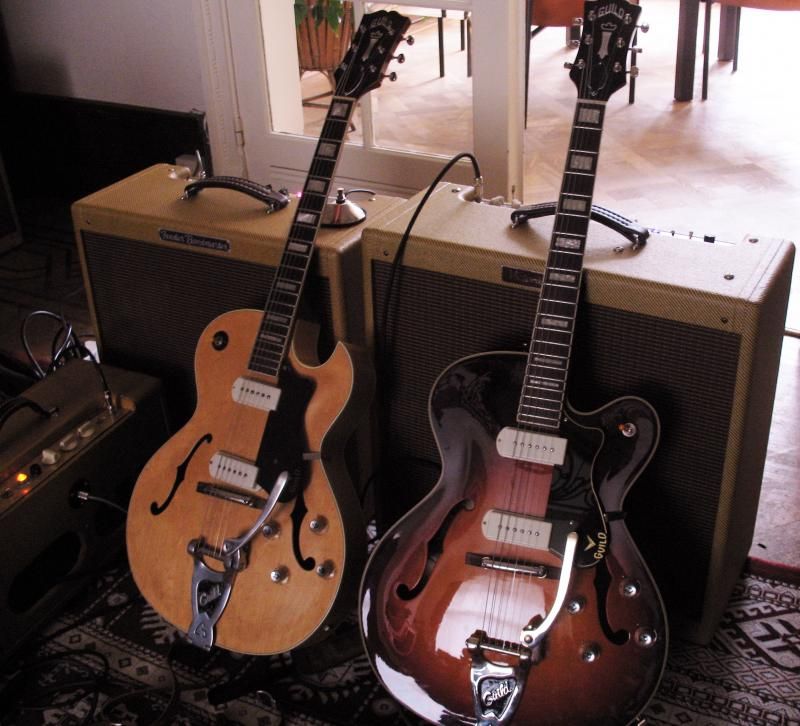jcwu
Senior Member
Did some more A/B testing today, and it really gets awful close. They're staying for now.

Hey, I just noticed the sequential years:
-1960 CE100D
-1961 Starfire III Special
-1962 X175
-1963 X175
Was that on purpose?
Did some more A/B testing today, and it really gets awful close. They're staying for now.

Haha, no, not on purpose. Except for this : my first Guild was the '62 X175. I love that guitar (and have used it) so much that I purposely went looking for its twin. The body is slightly bigger, deeper and heavier (thicker top and back) than the preceding years, and it took me buying (and eventually selling) a '60 X175 to find out that makes for a different playing experience and sound. Now I have a late 62 and an early 63, and they're probably as close as you can find them - the 62 has a hair more neck angle, slightly thinner neck, and a different sunburst, but otherwise, they're near identical. I got lucky with both of them, didn't pay all that much.Hey, I just noticed the sequential years:
-1960 CE100D
-1961 Starfire III Special
-1962 X175
-1963 X175
Was that on purpose?
Thanks! It sounds good, the stainless has a very clean, even sound. I was tempted to think all that steel could perhaps make the trebles a little brash and spikey, but the opposite is true, it's smoother sounding than a typical tune-a-matic bridge.Holy smokes...that looks superb!!!! Looks like a million bucks to me, especially with the Bigsby and Tru-arc. So how does that stainless steel sound, by the way?
I definitely hear the upper-mid honk in the reissues, as well. In fact, it's still there even after having them rewound down a bit.
But wouldn't 10" be a little too flat for the 9.45 radius fret-board? So would I still be struggling with the lower E, A, as well as upper upper E, B strings (in terms of low-action comfort)? And, how is the intonation with the Tru-Arc...no need for compensation "breaks" like on a Compton or even a Bigsby Comp Bridge/Bow-tie??
Oh, and I still haven't seen the new compensated Tru-Arcs whenever I visit the site. Do I have to ask and special order it from Tim?
You guys are comparing pups with freshly gaussed pickup magnets to guitars with pickups that are 60 plus years old. The magnets on the 50's Guild's are going to be weak unless they were recently gaussed. A weak magnet is going to contribute to a weak output.
My guess is if you had a time machine to back to the 50's and ride a fresh pair of original Franz pups you'd find a little higher output and a bump up in the mids.
Well...none of the old Franz pickups I have are anywhere near "low output", they're pretty angry little pickups. They just have a midrange bump that's pitched a little higher than a typical P90, or indeed the reissue Franzes. Which makes sense, as compared to both, they're underwound. I had my reissue Franz pickups rewound a little closer to the old ones I have, and they do sound closer.
Re: 10" radius Tru-Arcs - yes, you can get them, you can get pretty much anything you want from Tim for a small upcharge. I had a 7.5 radius one with slightly narrower string spacing made for my '60 Capri, it has an unusually round fingerboard. And it's a "half low rider" too, as that guitar doesn't have a huge neck angle. You can get a lot from Tim that's not on his webpage.
Since we are referring to cheaper alternatives to the more expensive "boutique" bridge replacements, I'm wondering how good a Bigsby compensated aluminum bridge would be.
You definitely have to slot Bigsby bridges, they don't work without string slots.BTW, does one have to file slots on the Bigsby Comp bridge? It seems most online stores that sell Bigsby CB require individual filing of slots. But can strings be used without the slots?
What do you think of the Bigsby aluminum bridges...good? So-so? Any thoughts on these?